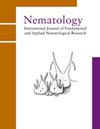Morphological and molecular characterisation of Longidorus patuxentensis n. sp. (Nematoda: Longidoridae) from Maryland and California, USA
IF 1.1
4区 生物学
Q2 ZOOLOGY
引用次数: 0
Abstract
Summary A new needle nematode species, Longidorus patuxentensis n. sp., was collected along the banks of the Western Branch Patuxent River from Upper Marlboro, MD, USA, and described herein. Female body length of the new species ranges from 3.8 to 5.2 mm, with a set off lip region by depression, 77-92 μ m long odontostyle, 40-53 μ m long odontophore, vulva located at 46.3-50.1% and tail conoid with bluntly rounded tip. The new species has four juvenile developmental stages and no males. It looks morphologically similar to L. breviannulatus , L. elongatus , L. martini , L. americanus , L. grandis , L. sabalanicus and L. sturhani by having a ventrally curved to spiral body, generally similar lip region and conoid tail with a rounded terminus, but differs from these species by the odontostyle, odontophore, total stylet length and a few other characters. Phylogenetic analysis of the D2-D3 expansion segments of 28S rRNA gene sequences placed L. patuxentensis n. sp. in a clade with L. litchi , L. fangi , L. jonesi , L. diadecturus and Longidorus sp. The D2-D3 sequence of L. patuxentensis n. sp. was identical to that of Longidorus sp.5 collected from Juglans sp. growing in Butte County, California, USA. The D2-D3 of 28S and ITS1 rRNA and COI gene sequences indicated that the Maryland and California populations belong to the same species, described herein as L. patuxentensis n. sp.美国马里兰州和加利福尼亚州长线虫科长线虫的形态和分子特征
摘要在美国马里兰州上万宝路(Upper Marlboro)帕塔克森特河(Patuxent River)西部支流河岸采集到一种针状线虫,并对其进行了描述。新种雌体体长3.8 ~ 5.2 mm,唇部凹陷,齿柱长77 ~ 92 μ m,齿孔长40 ~ 53 μ m,外阴占46.3 ~ 50.1%,尾圆锥形,尖粗圆。这个新物种有四个幼年发育阶段,没有雄性。在形态上与L. breviannulatus、L. elongatus、L. martini、L. americanus、L. grandis、L. sabalanicus和L. sturhani相似,具有腹弯至螺旋形的身体,大体相似的唇区和圆锥形尾部,末端为圆形,但在齿柱、齿孔、总柱头长度和其他一些特征上与这些物种不同。通过28S rRNA基因序列D2-D3扩增片段的系统发育分析,将帕塔克森l.s patuxentensis n. sp.与L. litchi、L. fangi、L. jonesi、L. diadecturus和Longidorus sp.属同一支系。帕塔克森l.s patuxentensis n. sp. D2-D3序列与美国加利福尼亚州Butte县Juglans sp.5中收集的Longidorus sp. D2-D3序列相同。28S和ITS1 rRNA的D2-D3序列和COI基因序列表明,马里兰和加利福尼亚居群属于同一种,本文将其称为patuxentensis n. sp。
本文章由计算机程序翻译,如有差异,请以英文原文为准。
求助全文
约1分钟内获得全文
求助全文
来源期刊

Nematology
生物-动物学
CiteScore
2.60
自引率
33.30%
发文量
67
审稿时长
3 months
期刊介绍:
Nematology is an international journal for the publication of all aspects of nematological research (with the exception of vertebrate parasitology), from molecular biology to field studies. Papers on nematode parasites of arthropods, and on soil free-living nematodes, and on interactions of these and other organisms, are particularly welcome. Research on fresh water and marine nematodes is also considered when the observations are of more general interest.
Nematology publishes full research papers, short communications, Forum articles (which permit an author to express a view on current or fundamental subjects), perspectives on nematology, and reviews of books and other media.
 求助内容:
求助内容: 应助结果提醒方式:
应助结果提醒方式:


